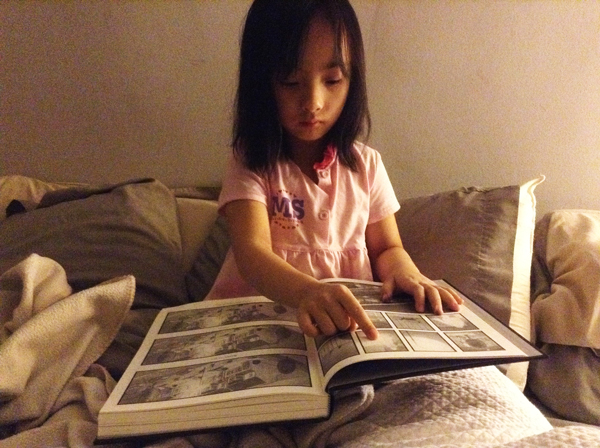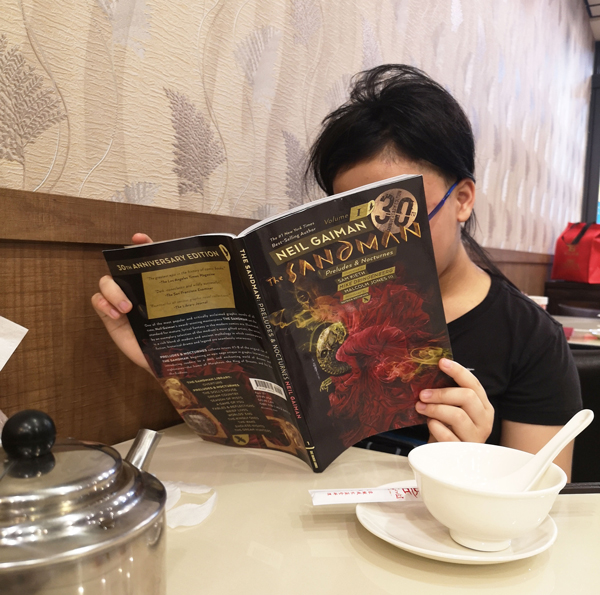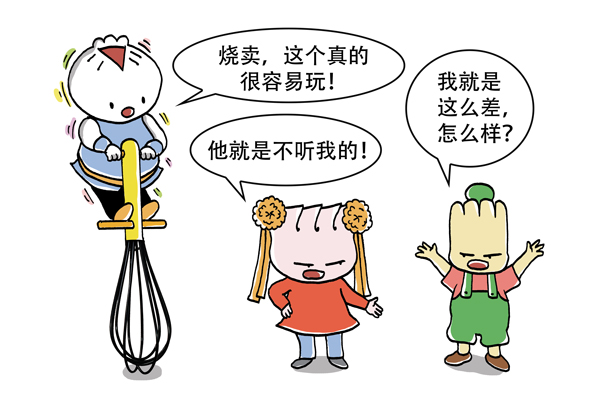Many classrooms employ reading levels charts for their students, but up-to-date research is showing that this way of regulating students’ reading doesn’t have strong scientific evidence to support it. This is why we have deliberately shied away from categorizing the Dim Sum Warriors stories using strict reading levels.
#1: Our Reading Levels Chart Experience Has Not Been Positive
In 1st grade, my daughter, YB (short for “Yakuza Baby”, the nickname we gave her because she was born while Colin and I were watching a Japanese gangster movie), had fallen in love with reading and was fast becoming a “bookworm”.
And then she got into graphic novels and brought one to school for her reading time.

The kids were told they could pick their own books for reading time, and had to write a short report on what they were reading.
YB’s teacher, Mister P, emailed me later to say she was not allowed to bring the graphic novel to school for reading time. I asked him why.
Mr. P replied that it was because he did not know the reading level for the graphic novel, and thus wouldn’t be able to effectively evaluate YB’s reading level if he allowed her to read it and write a report on it.
YB told me that the books in their classroom were all classified into baskets marked with different “levels”, but she found most of them really boring because they were written specifically to fall within their “levels”.
YB and I were both dumbfounded, because it seemed like “the appropriate reading level” was prioritized over “the appropriate interest level”.
Picking books at the “appropriate reading level” seems to make some kind of logical sense, because we want to push kids, but don’t want them to get frustrated.
BUT if leveled readers are the ONLY source of reading, it will put kids off reading because it prevents them from being surprised by language, learning new vocabulary, and finding words that actually express what they are thinking.
We thought of books like The Snowman by Raymond Briggs which doesn’t have any words, but which is really quite wonderful and beautiful, with a sophisticated narrative that belies its complete absence of text.
Then there are books, like The Gruffalo by Julia Donaldson, that YB would return to even though she was well past its “reading level”, because she liked the rhythm, rhyme, witty structure and illustrations.

Linguistic levels are also ultimately an arbitrary construct; they have some limited uses, but to elevate their importance seems like putting the cart before the horse.
Telling a child they can only read according to a Reading Levels Chart is unnecessarily restrictive.
Shouldn’t we be celebrating the fact that a child is willing to grapple with challenging texts out of interest?
By this time, YB was already reading series like Harry Potter or His Dark Materials—books that were definitely not in the various reading levels baskets in her class. In fact, in the 2nd grade, her English teacher let YB get books from the baskets in 3rd and 4th grade classrooms because she had well surpassed the reading levels in her own class.
We witnessed the efficacy of interest when we moved from New York to Taiwan. YB had to join a 3rd grade Taiwanese classroom, where her reading and writing level in Chinese was absolutely zero.
The Chinese equivalents of the books she was reading in English (her favourite book then was The First Fifteen Lives of Harry August by Claire North) were way beyond her abilities.
But if the premise or plot elements of the Chinese books intrigued her, we would stoke her interest. This usually prompted her to seek either my or her tutor’s help to figure out the story. This happened especially with Zijin Chen’s 2014 novel, Bad Kid (坏小孩), after she was enthralled by its TV adaptation. She was so taken with the story that she wanted to see how the series diverged from the original text.
Going from zero Chinese to powering through a Chinese novel in just over 2 years really proved the power of interest as a motivator!

#2: The Idea That Choosing Books Based on Reading Levels Charts Produces Better Literacy Results Doesn’t Hold Water
After looking closely at the research on Reading Levels, Timothy Shanahan (Founding Director of The Center for Literacy, University of Illinois, Chicago), who started his teaching career as a proponent of reading level charts, discovered that the evidence that matching reading text levels to kids’ reading abilities produces better results just doesn’t hold water.
Meanwhile, psychologists and authors of “The Psychology of Reading”, Paula Schwanenflugel and Nancy Knapp wrote in Psychology Today about the problems with relying too heavily on reading level charts to make decisions about reading content for kids.
-
- First: The reading level of texts has the veneer of science but is in fact highly inaccurate.
- Second: The tests for each individual’s reading level are highly unreliable.
- Third: Interest, motivation and connection with the text are all very important in terms of whether a child is able to read a text—and none of these factors are accounted for in the way reading level charts are constructed.
According to Timothy Shanahan, what’s most important is not to align text and readers along a reading levels chart, so that kids choose “books easy enough to ensure good reading,” but rather to “provide enough scaffolding to allow them to read harder books successfully”. In other words, don’t choose easy books, but choose interesting books, and provide the support to read them. This view is also supported by the reviewers at the School Library Journal (see Reading Levels Unfairly Label Learners Say Critics).
Librarians have also experimented with a more natural classification of books instead of by reading levels; for example, by genres—much like how we choose content to watch on Netflix—or by themes or by authors. When I think about books that my daughter and I share, whether it’s in English or Chinese, the labels are never about reading levels. We might say, “oh I think you will enjoy this book” because “it’s about third-culture kids” or “it has a strong girl heroine” or “it’s about a kid who goes to the kind of school you went to”.
So when our daughter enjoys a particular author, she would naturally start looking for more books by the same author, irrespective of reading level. So, for instance, after reading Neil Gaiman’s Coraline and The Graveyard Book, she was willing to invest the effort in grappling with his more challenging work, like Good Omens and The Ocean at the End of the Lane.

I would guess that this is the case for many of us as well!
#3: It’s Incredibly Hard to Create Funny Books Starting with a Reading Levels Chart!
With the Little Dim Sum Warriors series that Colin and I co-write, we begin with the everyday experiences of kids, such as recalling incidents we had observed in the playground and what we are observing about our own daughter. We wanted the stories to be relevant to children’s lives… albeit in cute dumpling form.
So, for example, watching kids in the playground struggle with learning how to ride a bike while various well-meaning older kids and adults yell instructions at them (often causing even more stress) became the backbone of our book, “My Way Is The Best 我的方法最好!” –a story that examines the learning process for many things.
Meanwhile, watching our daughter get incredibly frustrated with her own artwork, and then try repeatedly to begin from scratch instead of just fixing the wrong part, evolved into the story, “I Don’t Want Any Mistakes 我不希望出任何差错!” – where Xiajiao is trying to stop mistakes from happening, even though mistakes are inevitable.
Our writing process goes like this: Once we finish a draft with the relevant story beats, we ask ourselves key questions like, “is the story funny?” and “can kids connect with this story?” And then we go through it again to see if the language can be edited to connected with our audience better.
We would then work with our Chinese translator, Prof. Wenchi Lin, Dean of the College of Liberal Arts at National Central University in Taiwan, to figure out if we can make the language even funnier and more interesting.
We tried designing a story around a prescribed set of words based on a reading levels chart and it was incredibly difficult to retain the humor and even harder to match English words with Mandarin words such that the stories are funny in both languages.
We decided that it was ultimately a fool’s errand.
There are already so many leveled readers in schools, and other companies have produced thousands of leveled books for Chinese and English learning. Based on our surveys, these “educational” books with clear “levels”, often languish on library shelves or are read only when assigned as schoolwork. They are highly unlikely to intrigue kids enough to be picked up willingly.
We wanted to create books that kids actually enjoy, and would spark interest in pursuing the language—not merely vehicles for delivering vocabulary or rules of grammar.
So our stories prioritize kids’ actual interests, so that they feel resonance and relevance, and are put on a path to wanting to learn more, regardless of unfamiliar vocabulary. We then incorporate the appropriate scaffolding (such as home language, pictures and sound) to help them to make the necessary connections. Our approach is based on the same logic behind why so many kids devoured the Harry Potter series, despite words like ‘Horcrux’ and ‘Dementor’ not being on any prescribed vocabulary list.
And really, what kids need are books that get them to continue reading MORE books, like voracious little book worms.

Here’s Where We DO use a Reading Levels Chart
But we are not absolutists or ideological about reading levels charts.
We DO use them—but only as a guide for teachers as they plan their curriculum and try to match the lessons to local and international standards.
For schools using Dim Sum Warriors, we provide a leveled list of titles, based on matching the difficulty of the vocabulary in our stories to HSK levels, in order to facilitate lesson planning.
Our internal levels are:
- Foundational 易 (HSK 1-2)
- Intermediate 中 (HSK 3-4)
- Advanced 难 (HSK 5-6)
Teacher curriculum design is the one place where we feel the use of reading levels is useful.
In the App, however, students are encouraged to roam and read the texts based on their interests! Don’t worry about levels at all!
Dr. Yen Yen Woo works on educating for a multicultural and multilingual world through popular culture. She most recently co-created the Dim Sum Warriors app, characters and stories for Bilingual Learning. She has a Doctorate in Education from Teachers College, Columbia University and has been a tenured professor of education. She is also an award-winning film director and screenwriter. Her works have been licensed by HBO and Netflix and featured on BBC, Fast Company, Wired, and other global publications. Email: yenyen@dimsumwarriors.com.


